Air Raid to Al-Waleed (24)
The Story of Demolishing Fighters and the Equipment in Al-Waleed Triple Military Bases Known as H-3
2016-6-19
Air Raid to Al-Waleed (H-3)
The Story of Demolishing Fighters and the Equipment in Al-Waleed Triple Military Bases Known as H-3
By: Brigadier General Ahmad Mehrnia
Tehran, Sooreh Mehr Publications Company
2010 (Persian Version)
Translated by: Zahra Hosseinian
The team enters the Iraq territory from far north and through heights continues flying towards target. To make easier and safer flight, the operations carry out in the form of two teams consisted of four aircrafts flying close to each other. In this journey, any carelessness can cause the plan fail. The team flies so close to the Turkish border that it is possible the Air Force of this country will be sensitive to the issue in the case of being reconnoitered by Turkish radars. Retired General Ahmad Soleimani, who had observed the flight team from the rear cabin of last aircraft, says about flying on this route:
"We were sent on a mission in two teams of four aircrafts. In an organized collaborative flight and in quite specified situations, the first team flew, but behind them the other four aircrafts almost separated and each one kept flying in their desired position; Eskandari, the leader of second four aircrafts, maneuvered through valleys skillfully; the other one flew above the mountain ridge; briefly, each one had chosen a position. We also followed others and flew lower than them. In fact, I was the last one of team. I looked above and observed the other members’ situation from the rear cockpit. Five or ten minutes after our entrance to the Iraqi territory, the click sound of radio and then the word ‘top’ from Javanmardi caught my attention! I glanced quickly over our heads and in a quick search, I saw two Iraqi Mig-23 fighters circulated toward south at about more than five thousand feet and continued the rout. At first I was very worried and wanted to fill others in on the situation by radio, but I regretted and through internal communication I said to Manouchehr in the front cabin, ‘Sir! Look, two fighters of enemy are above us.’ Now both of us were careful about any hostile movement from them and soon realized that they were moving away from the area. I had no doubt that our prayers answered and God has closed their eyes on us. Therefore, our concern has been resolved and we kept flying."
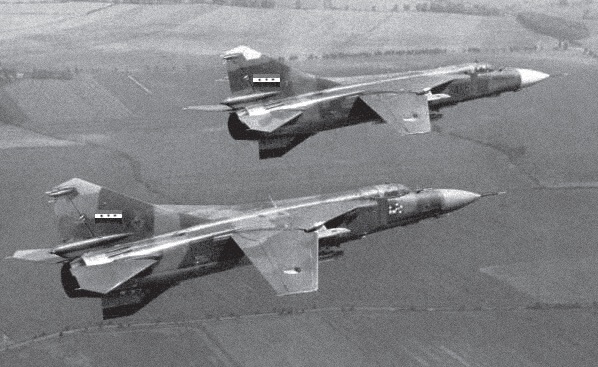
Two MiG-23 on patrolling
Retired Amir and liberated prisoner, Ravadgar says about that flight:
"Mountains of northern Iraq were deep in snow and had dreadful valleys; so that I said to my colleague in the rear cabin I thought it is better we let the aircraft crash and being killed, if any problems happen to us or enemy fighters track us and target; because jumping into the valleys, extreme coldness, and wild animals will kill us with more torture! Of course I was just joking, because we pilots have trained to survive in harsh conditions and able to tolerate crisis and difficult situations for a while in every condition."
***
When Phantoms leave the region, tankers also leave the south of Lake Uremia toward Mehrabad and two hours later, two other tankers 707, piloted by Capt. Abbas Amouee and Capt. Gholam Hossein Esfahani, Capt. Hussain Eskandarian and Capt. Parviz Varzandi, take off from Mehrabad runway and head to the mentioned region to deliver needed fuel to Phantoms, when they return.

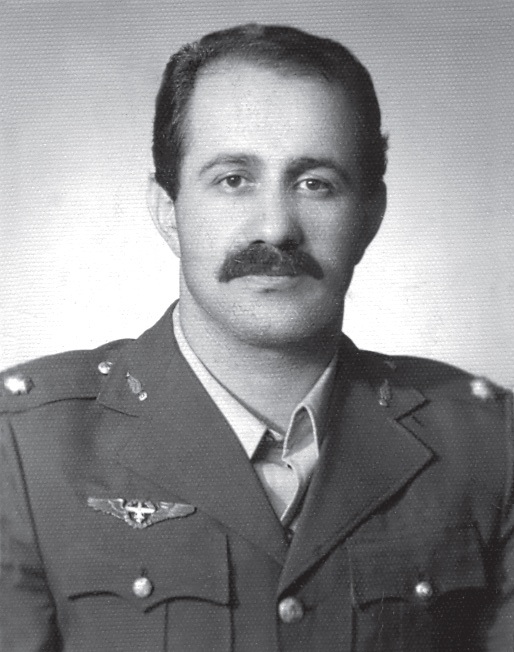
Capt. Abbas Amouee and Capt. Hussain Eskandarian
Retired Second Brigadier General Varzandi, who was seasoned pilot of F-5 and F-4 fighter, spoke about the difficulty in fueling and delivering fuel in low altitude, which limited their maneuverability, and stressed that Boeing 707 not designed for this purpose. Also, noted the operation pressure on phantom pilots and said: "I knew in what difficult situation they are, because I myself had fueled several times."
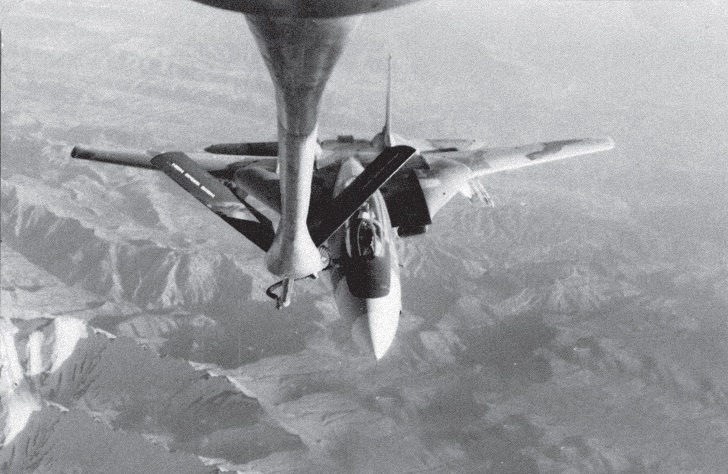
Tomcat or F-14 is refueling from tanker, photo from the chamber of delivering fuel
In a Boeing 707, Fariborz Babrzadeh[1] and Capt. Ali Asghar Motlaq Majd also had the responsibility of delivering fuel to air cover F-14 and F-4 aircrafts in the West of the country. Meanwhile, the purpose of this flight was that if any problems occurred for each of tankers existing over the lake, immediately being replaced. Four hours duration has been recorded for this flight. The flight engineers of mentioned aircrafts have been: Second Technician Mohammad Hossein Habibi Kheshtmasjedi, Second Technician Houshang Torabi and Third Sub Lieutenant Mehdi Ra’ahvarian. Boom operators of these three flights were also:
1. First Technician Nasser Sheer-razm;
2. Senior Master Sergeant Ali Reza Rahimi Parsa;
3. Sub Lieutenant Saber Abdulrazaq.
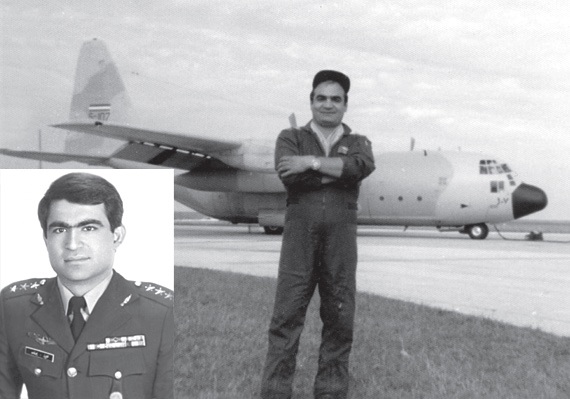
Brigadier General Ali Asghar Motlaq Majd beside the C-130 aircraft; Left: Captain Fariborz Babrzadeh.
Retired Second Brigadier General Ibrahim Pourdan says about the memory of attack to H-3:
"Briefing the flight was performed by the leader. Mentioning the risk of more than 80 percent in this operation, he said: "If someone has a problem or personal condition, he can refuse to come, because we have reserves." Getting relevant information, we found out that something more dangerous than ever is before us. When we headed to refueling location, my feeling was that there is no return, because it took around 20 minutes to find the tankers in radio silence; while we were on our territory, knew the region roughly, and there was no threat. Therefore, I said to Major Kazemi in the front cabin:
"We are unable to find tankers here, so how should we find them in the foreign territory under threats and stress?" we saw, of course, the tankers meanwhile and did the refueling operation. But the idea had been occupied my mind during long rout. I tried to enjoy seeing nature, however, in the last hours of my life! Therefore I often looked out of the cabin.
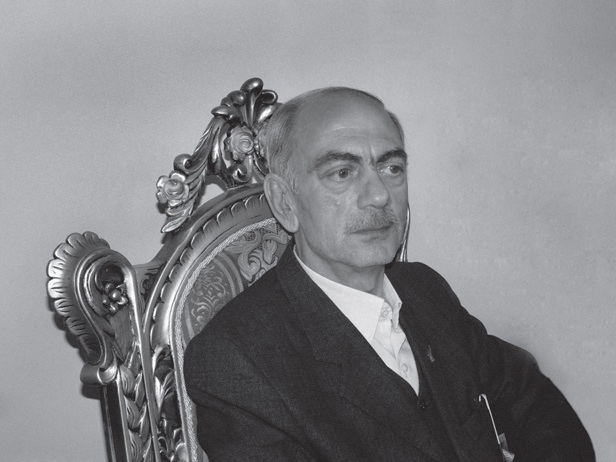
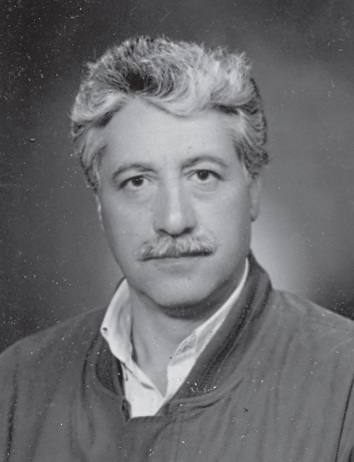
Second Brigadier General Naser Kazemi and Ibrahim Pourdan, 2009
I was very excited: our North West mountainous area covered with snow, strange valleys in our flight rout at the northern Iraq, their special shapes made the hair stand on end, also was deep in snow and ice. I thought if we had to leave the aircraft here, nobody can find any trace of our aircraft and us. Kazemi had exactly the same idea. He said, "Ibrahim! If we crash here, may be thousands of years later somebody finds any trace of us, like the mammoth elephants!" But when we climbed up a little and throw a glance at the southern slopes of the mountains, everywhere was green and verdant. When we got into Iraq from the West, we were met different region, an infertile land and desert; so that we had difficult situation for flying at the low altitude.
It was the last moments of flying in northern Iraq when Kazemi passed on me good news: it has been planned that we fly north-south route through Syria border instead of Iraq territory and to refuel there. Although I was a load off my mind we will be in more secure at long distance, but still I thought if we find tankers at the determined place? Because our height was lower in this situation too. But you can’t believe that we reached to the air-refueling tankers in the determined position right at the moment when we placed under them without even a second delay. I walked on air. Finally we were divided into three teams after separating from the tankers and reaching to the initial point.[2]
[1] Pilot Babrzadeh, Technician Poursaeed, Technician Torabi and Technician Rahimi Parsa have died in recent years. Rest in peace!
[2] For shooting the target, usually a certain point, such as road intersections, curves of rivers, land swell, or even an artificial occurrence near the target to be set, so that the speed direction to be carefully considered from this point according to the plan. The approximate distance from this point, which is called IP, is about 35 to 40 kilometers.
Number of Visits: 6170








The latest
- Third Regiment: Memoirs of an Iraqi Prisoner of War Doctor – 8
- 100 Questions/7
- Managing Oral History Interviews
- The 372nd Night of Memories – Part 1
- Third Regiment: Memoirs of an Iraqi Prisoner of War Doctor – 7
- Objects Tell What Happened in the Eight-Year War!
- 100 Questions/6
- Comparative Analysis of Women’s and Men’s Written Memoirs in the Sacred Defense
Most visited
- Third Regiment: Memoirs of an Iraqi Prisoner of War Doctor – 7
- Comparative Analysis of Women’s and Men’s Written Memoirs in the Sacred Defense
- 100 Questions/6
- Objects Tell What Happened in the Eight-Year War!
- The Importance of Pre-Publication Critique of Oral History Works
- The 372nd Night of Memories – Part 1
- Managing Oral History Interviews
- 100 Questions/7
Comparing the Narratives of Commanders and Ordinary Combatants in the Sacred Defense
An Analysis of Functions and ConsequencesThe experience of the Sacred Defense cannot be comprehended merely through statistics or official reports; what truly endures from war are the narratives of those who stood upon its frontlines. These narratives, however, vary significantly depending on one’s position, responsibilities, and lived experience.
Unveiling of the book "Oral History: What and Why"
The First report: Alireza KamariAccording to the Oral History website, the unveiling ceremony of the book "Oral History: What and Why" by Hamid Qazvini was held on Sunday evening, November 24, 1404, in the presence of experts in the field of oral history in the Salman Farsi Hall of the Arts Center.
Mohammad — The Messiah of Kurdistan
Boroujerdi immediately said to Darvish, “Ready a few men; we’re going.” Then he moved toward Mostafa, who was studying the Kurdistan map. Mostafa straightened his back and said, “During my service in the army I experienced a full-scale war in Kurdistan. Guerrilla warfare in Kurdistan follows its own rules. The anti-revolutionary commanders want to draw us into a battle chosen on their terms.”

